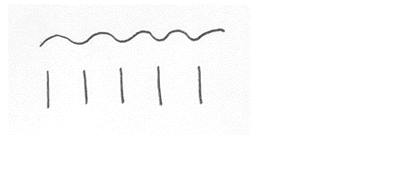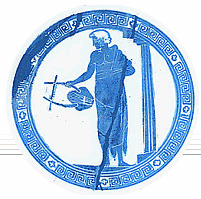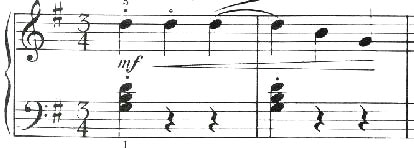|
TEXTURE,
HARMONY and FORM
| TEXTURE |
 |
|
 |
Texture
has to do with the way various musical sounds and melodic
lines blend. It is the interrelationship of voices and instruments.
When hearing texture in music one must ask oneself how many
melodies are occurring and how are they related? The three
textures in music are . A composition can start in one texture
and move freely into another.
 |
 |
Monophonic
|
 |
|
Polyphonic |
 |
|
Homophonic
|
| MONOPHONIC |
 |
|
 |
One main melody. (mono=one, phony=sound). A single-line melody
unadorned and unaccompanied. Often monophonic texture is not
enough information to continue to hold ones attention as an
artistic experience. The exceptions are vocal chants such as
plainsong and certain pieces sung a cappella such as, Amazing
Grace.

| POLYPHONIC |
 |
|
 |
Two
or more melodies of equal importance played or sung simultaneously.
The term frequently applied to polyphonic texture is counterpoint
or contrapuntal. There are two types of polyphony.
IMITATIVE
POLYPHONY
Melodic
lines sounding together with the same or quite similar melodies
at staggered time intervals. Strict imitative polyphony uses
the same melody that copies itself which is called canon or
round. In non-strict imitative polyphony you hear imitation
but it is not the exact melody chasing itself but a very similar
one.

NON-IMITATIVE
POLYPHONY
Two
completely different melodies going on at the same time. Two
distinctly different melodic layers floating in and out of
each other.
| HOMOPHONIC |
 |
|
 |
One
main melody of real interest combined with other sounds that
are markedly subsidiary. The "melody and accompaniment"
of music. One main melody with every thing else accompaniment.
A principal melodic line with subordinate sounds used as supportive
accompaniment.

When
notes or a chord or harmony sound simultaneously it can produce
stability or tension. These two types of harmonies are referred
to as:
CONSONANCE
Harmony
that is stable, non active, agreeable, free of tension, blending
and resolved.
DISSONANCE
Harmony
that is unstable, in opposition, conflicting, jarring and
unresolved. A dissonant chord leaves the listener with a feeling
of expectation. It takes a consonant chord to complete the
gesture created by a dissonance. Most good music has a combination
of consonance and dissonance.
Harmonies move in progressions that help form the key of a
piece. Each key is positioned around a tonic and harmony can
be formed from the tonic note or any other scale degree.
Harmonies can also help to change the key of a composition,
when necessary. The processes of changing keys in music is
called modulation. Harmony
like scales can be major or minor and classical music uses
those two primarily but eventually you will hear about or
get to know diminished, half-diminished, augmented, dominant
seventh and many more types of chords or harmonies.
| FORM |
 |
|
 |
Form
relates to the organization of music, its structure or plan.
A compositions ideas in time creates its form. The form of
a composition also has to do with its shape, arrangement and
relationship of various musical elements. Form is perceived
in terms of repetition, contrast, or variation. Form is usually
diagrammed with letters to indicate how sections relate to
each other through statement, departure or return. Composers
need some structure to their pieces. It is easier for a composer
to be creative when there is some guideline to follow. Below
are some of the basic forms. There are five basic forms for
which much of music is organized in.
| STROPHIC |
 |
|
 |
The
musical form having one section only with the same music played
or sung on each repeat; diagrammed as A.
In
the popular spiritual "Amazing Grace" the changing
lyrics holds the listeners attention while the melody stays
the same with each verse.
| A
|
|
Amazing Grace, how sweet the sound,
That saved a wretch like me....
I once was lost but now am found,
Was blind, but now, I see. |
| A |
|
T'was Grace that taught...
my heart to fear.
And Grace, my fears relieved.
How precious did that Grace appear...
the hour I first believed. |
| A |
|
Through
many dangers, toils and snares...
we have already come.
T'was Grace that brought us safe thus far...
and Grace will lead us home. |
|
|
BINARY |
 |
|
 |
The
musical form having two contrasting sections, a first statement
followed by a contrasting statement; diagrammed as AB for
example the folk song "TwinkleTwinkle Little Star."
| A
|
 |
Oh,
say, can you see, by the dawn's early light,
What so proudly we hail'd at the twilight's last
leaming?
Whose broad stripes and bright stars,
thro' the perilous fight,
O'er the ramparts we watch'd,
were so gallantly streaming?
|
| B
|
|
And
the rockets' red glare, the bombs bursting in
air,
Gave proof thro' the night that our flag was still
there.
O say, does that star-spangled banner yet wave
O'er the land of the free and the home of the
brave? |
|
Listen
to Ternary form in Beethoven's piano piece, "Eccosaise."
The A section
The B section
The AB and then return to A section
| TERNARY |
 |
|
 |
The
three part musical form in which the last section repeats
the first. A musical form having a departure from the first
section and then a return of the first section; diagrammed
ABA. For example the folk song "TwinkleTwinkle Little
Star."
| A |
 |
Twinkle,
twinkle little star
How I wonder what you are, |
| B
|
|
Up
above the world so high,
Like a diamond in the sky, |
| A |
|
Twinkle,
twinkle little star
How I wonder what you are.
|
|
| VARIATION |
 |
|
 |
The
musical form or repeating a clearly defined melody (theme)
and successively changing it artfully and cleverly without
ever losing touch with the original melody. In variation form,
as each section re-dresses the main theme, the main theme
is always present in the listener's ear; diagrammed as
| A
|
 |
There
was a man lived in the moon,
lived in the moon, lived in the moon,
There
was a man lived in the moon,
And his name was Aiken Drum;
And
he played upon a ladle,
a ladle, a ladle,
And
he played upon a ladle,
And his name was Aiken Drum. |
| A1
|
|
And
his hat was made of good cream cheese,
good cream cheese, good cream cheese,
And
he played upon good cream cheese,
And his name was Aiken Drum. |
| A2
|
|
And
his coat was made of good roast beef,
good roast beef, good roast beef,
And
he played upon good roast beef,
And his name was Aiken Drum. |
| A3
|
|
And
his buttons were made of penny loaves,
penny loaves, penny loaves,
And
he played upon his penny loaves,
And his name was Aiken Drum. |
| A4
|
|
And
his waistcoat was made of crust of pies,
crust of pies, crust of pies,
And
he played upon his curst of pies,
And his name was Aiken Drum. |
| A5
|
|
etc.
|
|
A A1 A2 A3 A4 A5 etc.
|
RONDO |
 |
|
 |
Periodic
return of a central theme; diagrammed as ABACADA.
| A
|
 |
I
know a man named Michael Finnegan, |
| B
|
|
He
had whiskers on his chinigin,
The
wind blew them off, but they grew in again,
Poor
old Michael Finnegan. |
| A
|
|
I
know a man named Michael Finnegan, |
| C
|
|
He
went fishing with a pin-agin,
Caught
a fish and dropped it in-agin
Poor
old Michael Finnegan. |
| A
|
|
I
know a man named Michael Finnegan, |
| D
|
|
Climbed
a tree and barked his shin-agin,
Took
off several yards of skin-igin
Poor
old Michael Finnegan. |
| A
|
|
I
know a man named Michael Finnegan, |
| E
|
|
He
got fat and then got thin again,
Then
he died and had to begin again,
Poor
old Michael Finnegan.
|
|
|







